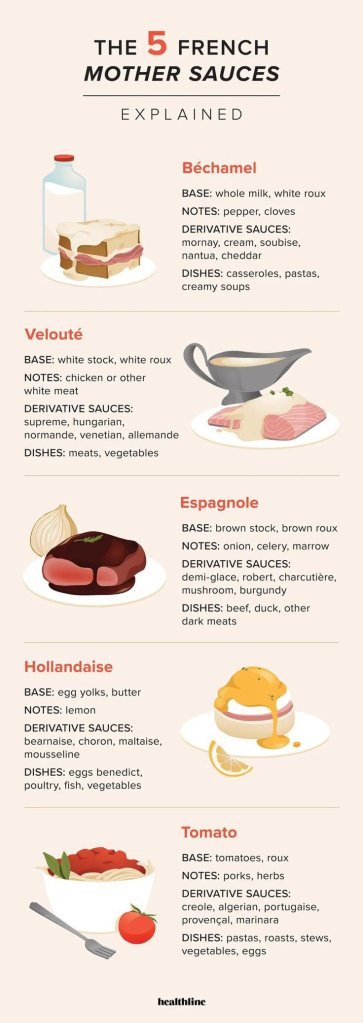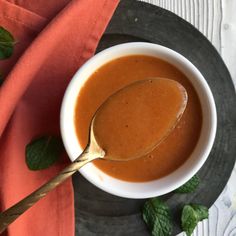What is sauce ?
Sauces are liquids or semi liquid mixtures. A keen sense of smell, delicate sense of taste,
a light, strong hand for the blending, all contribute to the perfect sauce.
Long ago, Grimande de la Royere, philosopher and gastronomer wrote: “the sauce is to
culinary art, what grammar is to language.”
A perfect sauce has a colorful appearance, is glowing in its rich smoothness, its texture
is that of velvet, and it has a natural flavor and complements the food it accompanies,
rather than mask its taste. It provides moisture, color and shine to food.
Uses of sauce ?
- Enhances flavor.
- Some sauces help in digestion, example mint sauce and apple sauce with roast
pork. - It gives moistness to the food, white sauce adds creaminess to firm and dry food.
- Adds color to food, hollandaise sauce served on vegetables adds color.
- Served as an accompaniment, sometimes gives a contrast taste to another food,
example cranberry sauce with roast pork. - Sometimes gives name to the dish, example Madeira wine when added to brown
sauce, it is called sauce Madeira. - Enhances nutritional value of the dish.
- Dresses and compliments food that need some additional quality and makes the
food more palatable, example Chaufroid sauce is used to coat various food items,
and gives a god appearance. - Gives tartness and contrasts or balances a bland food, example Devil sauce
served with eggs give appealing tartness.
Composition of Sauces
Liquid:- the body of sauce
a. White sauce:- Milk,
b. Veloute sauce:- White stock,
c. Tomato sauce:- Vegetable stock or tomato puree,
d. Brown sauce:- Brown stock,
e. Mayonnaise sauce:- Salad/olive/vegetable oil,
f. Hollandaise sauce:- Butter
Roux:- thickening agent
a. Types of Cooked Roux (White, Blond and Brown)
The flavorings and seasonings
Classification of sauces

The classification of sauces are based on technique used to prepare them. For example all the thickened sauces are thickened with thickening agents and emulsified sauces are made through emulsification.
Mayonnaise sauce is usually a controversial sauce to be included in French classical mothers sauce. Yet still it remains in a debate but it is total 6 in Auguste Escoffier French classical book.
Miscellaneous sauces are made from a particular product and flavored and used as base or accompaniment to a dish such as apple sauce, mint sauce, strawberry coulie etc.
Proprietary sauces are made in bulk and sold in market places such as Tabasco sauce, Worcestershire sauce, soy sauce.
French Mother sauces

Miscellaneous Sauces
- Bread sauce: served with roast chicken
Flavored milk + onions + fine bread crumbs + butter + cream + seasoning - Mint Sauce: served with roast lamb
Chopped mint leaves + castor sugar + vinegar - Apple sauce: served with roast pork
Apple puree + cinnamon powder + sugar + butter + water - Cranberry sauce: served with roast turkey.
Cranberries + sugar + water - Horseradish sauce: served with roast beef
Grated horseradish + vinegar + seasoning + lightly whipped cream
- Roast gravy: all roasts
Drippings/essence of roast meats + brown stock
Not a sauce but an accompanying with roasts. - Pan Gravy:
It is made using meat juices which congeal and caramelize. De glaze the trays or
pans with wine or water. The gravy can be thick or thin and can be flavorful or
plain. - Jus-lie:
It is made by simmering roast gravy with the addition of little tomato puree, a
few mushroom trimmings and a pinch of thyme for 10 – 15 minutes. Then lightly
thickened by stirring into the simmering gravy some arrowroot diluted in cold
water. Re-boil, simmer for 5 – 10 minutes and pass through a strainer. - Jus Rôti (Roast Juices):
A jus that comes from deglazing the roasting pan with stock, water or wine. The
result is a juice that carries the flavor of the roast and is usually served unthickened but defatted.
Recipes of Mother sauce

How to make French Brown sauce ?
It is made from brown roux and brown stock, or glaze of brown stock. It is one of the
most widely used basic mother sauces. Demi-glaze is a derivative of brow stock and is
widely used for the preparation of other brown sauce derivatives

How to make French Hollandaise sauce ?
Hollandaise sauce, also called Dutch sauce, is a mixture of egg yolk, melted butter, and lemon juice and usually served with eggs Benedict, vegetables such as steamed asparagus.

How to make French Veloute sauce ?
Veloute sauce is one of the basic French mother sauces made of chicken stock or fish stock thickened with blond roux. It is usually served with poached meats and so on.

BECHAMEL SAUCE – French Mother Sauce
Bechamel sauce is a rich creamy sauce made by cooking one parts of flour and butter t0 10 parts of milk with flavorings. It is also known as white sauce and one of the classical French mother sauces.

TOMATO SAUCE- CLASSICAL MOTHER SAUCE
Tomato sauce is a classical French mother sauce made from ham, bacon, tomatoes and herbs and used as accompaniments or base.

MAYONNAISE SAUCE
Mayonnaise sauce is a classical mother sauce in French cuisine made from eggs and oil which is also known as cold sauce. It is great accompaniment to tandoori dishes and a great dressing for salad.
Finishing of Sauces
Certain finishing techniques are use to develop derivatives from the basic mother
sauces. There are a great many ways of modifying or adding to a sauce. Among these
methods are a number of basic techniques that are used over and over again for making
sauces.
Reduction: Using reduction to concentrate basic flavors: – If we simmer a sauce for a
longer time, some of the water is evaporated, and the resulting product is more
flavorful. This is the same technique used when making glazes from Stocks. Some
reduction takes place in nearly all sauces depending on how long they are simmered.
Using reduction to adjust textures: – Concentration a sauce by reduction also thickens
it, as only the water evaporates. If a sauce is too thin, it may be simmered until it
reaches the desired thickness.
Using reduction to add new flavors: – Reductions are used to flavor sauces.
Reductions of other liquids especially red and white wines, with different flavoring
ingredients, herbs and spices, are used a great deal in this way.
Reduce wines by boiling.
Reduction lessens the acidity of white wine. Red wine reduction makes its perfumes strong. This is also true for Brandies. Fortified wines have delicate perfumes that are easily destroyed. They work best unheated and added at the last minute.
Straining: A Sauce should always be smooth and lump-free. To bring a sauce’s texture
to perfection, to create the velvety smoothness straining is necessary. Straining through
a china cap lined with several layers of cheesecloth is effective. Straining is usually done
before final seasoning.
Deglazing: To de glaze means to swirl a liquid in a sauté pan or other pan to dissolve
cooked particles of food remaining on the bottom of the pan. It is an important
technique for finishing sauces that accompany sautéed items.
A liquid such as wine or stock is used to de glaze a sauté pan and then reduced by one-half or three- fourths. This reduction with the added flavor of the pan drippings is then added to the sauce that is served with the item.
Enriching: Liaison: In addition to being a thickening agent, the liaison of egg yolks and
cream is used to finish a sauce by giving extra richness and smoothness.
Heavy cream: Heavy cream has long been used to give flavor and richness to sauces.
Butter: A useful enriching technique, both in classical and in modern cooking, is called
finishing with butter, or monter au beurre.
To finish a sauce with butter, simply add a few pieces of softened butter to the hot sauce and swirl it in until it melts. The sauce then should be served immediately. If it is allowed to stand the butter may separate out. Finishing a sauce with butter gives it a little extra shine and smoothness, as well as adding to it the rich, fresh taste of raw butter.
Seasoning: Whether or not a sauce is to be given a final enrichment of liaison, cream, or
butter it must be checked carefully for seasonings before serving.
Remember the last step in any recipe, whether written or not is “adjust the seasonings”
Salt is the most important seasoning for sauces. Lemon juice also is very important.
These two seasonings emphasize the flavors that are already there by stimulating the
taste buds.
Cayenne and white pepper are perhaps third and fourth in importance.
Sherry and Madeira are frequently used as final flavorings. These wines are added at the
end of cooking (unlike red and white table wines, which must be cooked in a sauce)
because their flavors are easily evaporated by heat.






